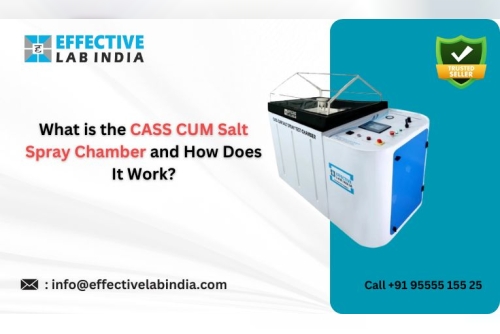The CASS CUM salt spray chamber is a special type of laboratory equipment designed for corrosion testing of materials, especially metal surfaces, coatings and finishes. This chamber is used in automotive, aerospace, marine and other industries, where it is important to ensure the durability of raw materials. "CASS" stands for Copper Accelerated Acetic Acid Salt Spray. A more complex salt spray test, commonly used for electroplated surfaces or organic coatings on metal substrates and to evaluate the corrosion resistance of the coating tip.
In this blog we will explore what the CASS CUM Salt Spray Chamber is, how it works, its main features and specifications so you can understand the role it plays in corrosion testing.
How Does the CASS CUM Salt Spray Chamber Work?The CASS Test Chamber simulates harsh environmental conditions to accelerate corrosion and evaluate how well materials or coatings can withstand such environmental conditions. The working principle is based on spraying salts, containing copper chloride and acetic acid, in a controlled atmosphere, usually at high temperatures.
Here’s a step-by-step breakdown of how the CSS chamber works:
Salt solution preparation: The experiment begins with a solution that contains specific amounts of sodium chloride (salt), copper chloride, acetic acid This combination creates a high temperature storm that resembles the natural environment on the high humid industrial areas. Placement of Test Specimens: The product or material to be tested is placed on racks or holders in the salt spray chamber. It is important to ensure proper storage of test samples for corrosive dispersion as well. Chamber sealing and temperature control: Once the samples are placed, the chamber is sealed which provides a controlled environment. The chamber temperature is usually set between 35°C and 45°C (depending on the specific test required), as evaporation is accelerated at higher temperatures. Spraying Method: A compressed nozzle sprays a fine saline solution onto the samples. This constant spray ensures that the test materials are continuously exposed to the solution, simulating long-term exposure to corrosive agents under real-world conditions. Monitoring the Test: The chamber runs for a set period of time, which can range from several hours to several days depending on the test data. During this time, the chamber maintains a constant temperature, humidity, and spray distribution. The test can also be stopped for temporary observation of the samples. Post-test inspection: At the completion of the test, the samples are carefully removed from the chamber and examined for signs of deterioration. The extent of corrosion, pitting, or other damage is examined to determine how well the product or coating performed. Features of a CASS CUM Salt Spray ChamberHere are some of the most important features that define a high-quality CASS Cum Salt Spray Test Chamber:
Fiber Reinforced Non Rusted Body Pneumatic Door Opening Full Automatic Touch Screen User Interface Temperature Range - 35°C/45°C Fog Collection Out-Side Humidifier Air Saturator in Build Solution Tank Auto Filling with Low-Level Alarm(Optional) Air Saturator Auto Filling with Low-Level Alarm(Optional) Air Purging System (Automate) Specifications of a Typical CASS CUM Salt Spray ChamberHere are some standard specifications of a typical CASS CUM Salt Spray Chamber:
Chamber capacity: From 250 liters to 1000 liters depending on the design. Temperature: Usually 35°C to 40°C. Display: 7-inch touchscreen-based HMI Test air pressure: 0.7Kg/cm2 - 1.2Kg/cm2, adjustable depending on test requirements. Salt solution: 5% sodium chloride (NaCl) solution with copper chloride acetic acid. pH range: The pH of the solution is normally maintained between 6.5 to 7.2 pH. Corrosion cycle: Continuous or cyclic perforation depending on the test data. Power supply: 220V, single phase, 50 Hz, 15 A, depending on location. Temperature control: Built-in PID temperature controller. Repeatability temperature of air saturation: ±2∘C. Minimum estimate of air saturator temperature: 0.1∘C. Test room temperature range: 35∘C ± 2∘C. Material: Fibreglass. Over Temperature Alarm: Yes Air Saturator Auto Refill: Yes Applications of CASS CUM Salt Spray ChambersThe CASS cum salt spray chamber (https://saltspraychamber.com/cass-test-chamber) finds applications in applications requiring rigorous corrosion resistance testing, including:
Construction: To evaluate the longevity of environmentally friendly construction materials.
Automotive: To test the durability of automotive parts and coatings, especially in salty environments.
Aerospace: Ensuring aircraft components can withstand environmental corrosion at high altitudes.
Marine: Equipment for testing ships and platforms in coastal areas with constant saline sea air.
Coatings Industry: Studies on the efficacy of protective coatings such as zinc, chrome and nickel coatings on steel.
ConclusionThe CASS Test Chamber is an indispensable testing machine for evaluating the corrosion resistance of materials and coatings. It helps companies maximize sustainability and improve safety measures by simulating harsh environmental conditions. Whether you are testing automotive, aircraft, marine, or industrial products, this build ensures that your product is ready to withstand the harshest conditions.
By clearly understanding how these instruments work and their basic features, you can ensure reliability and accuracy that meets industry standards.












